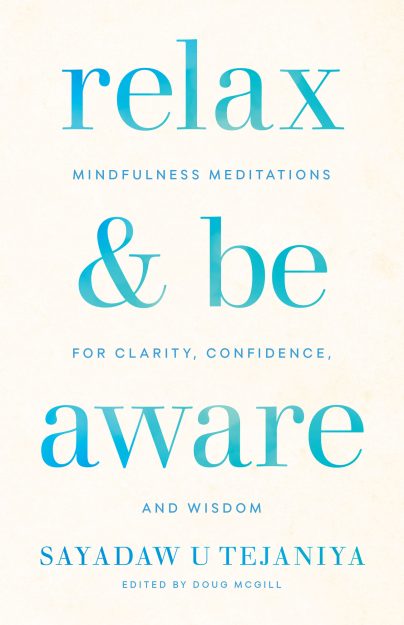When we meditate, do we think it is good to have a lot of thoughts in the mind? Or do we think it is better to have only a few thoughts, or even no thoughts in the mind?
If we believe it’s better to have few or no thoughts in the mind, then we are likely to resist thinking whenever thoughts arise in the mind.
But thinking is just nature. Can we stop nature or avoid nature? It’s impossible. Instead we merely need to see that thinking is nature. That is right view. With this view we can start to skillfully live with thinking instead of resisting the nature that is thinking.
You need to be able to recognize when the mind is thinking, but not get entangled in what is being thought. There is no need to get caught in the story your thoughts are telling. There is no need to automatically believe that the story running in the mind is true.
Rather, be interested in the fact that the mind is thinking. It’s a process that is happening. If you are not used to acknowledging that the mind is thinking, go back to whatever else you were being aware of, such as the breath or sensations in the body. Don’t stay just with the mind, because you can then get lost in thought.
If you frequently give yourself the opportunity to acknowledge the thinking mind, you will get to the point where you begin to see that this is mind. Then you can know it and not get lost in thought. There is a difference between being lost in thought, which is wandering mind, and being aware of thinking while thinking.
We begin to recognize that we can objectively know “this is mind.” We realize “this is mind, mind is thinking.” Once we learn how to see the mind objectively in this way, then we don’t get lost in thought.
When the mind is thinking continuously and we become aware of it, it’s not enough to just know the mind is thinking. We can notice the intention to think. The mind wants to think. We want to become able to see this desire clearly. Sometimes when we ask ourselves, “Why is my mind thinking so much?” we are able to detect the desire to think.
Once a meditator was watching her mind thinking and she asked herself this question: “Why is the mind thinking so much?” She suddenly realized it was because the mind wanted to entertain itself. Once we know the cause of so much thinking, that knowledge will slow or stop it.
When we look at thoughts in this way, we become able to understand certain processes such as cause-and-effect relationships between the mind and body, or how the mind labels “right and wrong.” We’re not interested in the content of the thoughts. We want to understand the phenomenon of thinking, especially in relation to the unskillful qualities of wanting certain things to happen (for example, wanting certain kinds of thoughts or images to arise in the mind) and other things not to happen (such as certain thoughts we don’t want to arise).
We can observe these processes clearly in relation to sounds we hear during meditation. See how the mind immediately labels such sounds as “good” or “bad.” We enjoy “good” sounds that we hear, such as the sounds of bells chiming, birds singing, or leaves rustling in the wind, and we grasp at them in the mind. We like them and want to experience them more. We don’t want them to stop. Likewise, we try to block out the “bad” sounds we hear, such as car traffic or construction noise.
It doesn’t matter how well you are concentrating. You could be in the depths of concentration, but when you hear a sound and you think it shouldn’t be there, you lose concentration instantly. You resent that the sound broke your concentration.
The moment we have wrong view, we have wrong thought, which is a thought of liking or disliking, or of evaluating an experience as good or bad. Then, instead of continuing to see reality clearly, we get entangled in desire and aversion. We start trying to manipulate nature instead of seeing it clearly and working with it skillfully.
In this way, our likes and dislikes thus cloud the clarity of the mind, but this is actually an opportunity to observe and learn in detail how the unwholesome roots do their work. To the degree we can understand them, to that same degree the mind is freed from desire, aversion, and delusion.
How about pain? Can we observe how the mind tends to automatically label any intensely unpleasant sensation as “pain” and therefore as “bad”?
We generally judge pain as a negative experience. The word itself feeds that image into our mind, so when we have pain, the mind’s automatic reaction, whether we are conscious of it or not, is to dislike it. When we come across discomfort in the body or the mind, we need to see this negative reaction clearly in the mind and to adjust it by bringing in right view.
We do this by reminding ourselves that pain is not inherently a negative experience. Pain is nature. It is neither good nor bad.
Only when we accept that pain is nature can we allow it and learn from it. Otherwise, we are so busy resisting pain that we can’t understand anything about it.
When there is pain, pain is just a physical experience, right? But the feeling “painful” is in the mind. For the same physical experience, there may be aversion in the mind toward it, or the mind may be equanimous toward it. So we need to work with the mind to understand more about its involvement in the process.
How does the mind interpret pain? How does the mind create pain for itself? How does it create the experience of “pain,” “painfulness,” and all the attendant pains for itself? For a non-meditator, it’s all together, all rolled up in one. But for a meditator, it’s different; you take it apart to find out more about it.
People with chronic pain have to learn on the go. What is the mind’s feeling toward the pain? What is the mind’s attitude toward the pain? What stance does it hold toward the pain? What do you already understand about the pain?
By inquiring about pain in this way, the mind learns how to understand pain with right view, not personally as “my pain,” but just as nature. When it’s not understood as my pain, it suddenly doesn’t hurt so much, or even at all.
Without aversion, pain is just another object to be known. It is impersonal. It doesn’t matter that the object happens to be pain. When pain becomes just nature, then it is no longer painful.
As you go about meditating the whole day, remember that whatever you observe, whether it’s in the body or the mind, whether it’s pleasant or unpleasant, it’s helpful to hold the view that “this is just nature, this is just a process.” This is the only difference between someone who is meditating and someone who is not meditating.

♦
From Relax and Be Aware: Mindfulness Meditations for Clarity, Confidence, and Wisdom by Sayadaw U Tejaniya © 2019 by Sayadaw U Tejaniya. Reprinted in arrangement with Shambhala Publications, Inc. Boulder, CO.
Thank you for subscribing to Tricycle! As a nonprofit, we depend on readers like you to keep Buddhist teachings and practices widely available.
